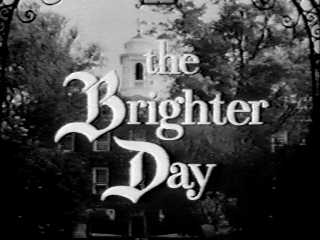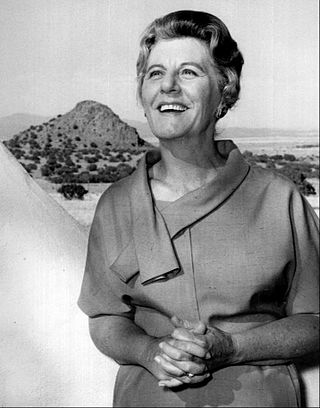
Irna Phillips was an American scriptwriter, screenwriter, casting agent and actress. She is best remembered for pioneering a format of the daytime soap opera in the United States geared specifically toward women. Phillips created, produced, and wrote several radio and television daytime serials throughout her career, including Guiding Light, As the World Turns, and Another World. She was also a mentor to several other pioneers of the American daytime soap opera, including Agnes Nixon, William J. Bell and Ted Corday.

Portia Faces Life was an American soap opera first broadcast as a radio series from 1940 to 1953, and then on television for a single season in the mid-1950s. It began in syndication on April 1, 1940 and was broadcast on some stations that carried NBC programs, although it does not seem to have been an official part of that network's programming. The original title was Portia Blake Faces Life.

The Brighter Day is an American daytime soap opera which aired on CBS from January 4, 1954, to September 28, 1962. Originally created for NBC Radio by Irna Phillips in 1948, the radio and television versions ran simultaneously from 1954–1956. Set in New Hope, Wisconsin, the series revolved around Reverend Richard Dennis and his four children, Althea, Patsy, Babby and Grayling.

Himan Brown, also known as Hi Brown, was an American producer of radio and television programs. Over seven decades, Brown produced and directed more than 30,000 radio shows, for all of the major radio networks and syndication. He worked with such actors as Helen Hayes, Boris Karloff, Peter Lorre, Gregory Peck, Frank Sinatra and Orson Welles.

Gertrude Warner was an American voice talent who played multiple characters on radio productions during the Golden Age of Radio.

When a Girl Marries is an American daytime radio drama that was broadcast on three major radio networks from 1939 to 1957. Created by Elaine Sterne Carrington, it was the highest rated soap opera during the mid-1940s.

Big Sister was a daytime radio drama series created by Lillian Lauferty and broadcast on CBS from September 14, 1936, to December 26, 1952. It was sponsored by Lever Brothers for Rinso until 1946 when Procter & Gamble became the sponsor.

Rosemary is an American radio soap opera broadcast on NBC Radio from October 2, 1944 to March 23, 1945, and on CBS Radio from March 26, 1945 to July 1, 1955. Starring Betty Winkler as Rosemary Dawson Roberts, the program's only sponsor was Procter & Gamble, primarily for Ivory Snow dishwashing liquid, Camay soap, Dash and Tide laundry detergents and Prell shampoo. The series was created by Elaine Carrington, who had previously created Pepper Young's Family (1932-1959) and When a Girl Marries (1939-1957).

Anne Seymour was an American film and television character actress.

Dorothy Lovett was an American film actress.
Kitty Foyle is an American old-time radio and television soap opera originally aired during the 1940s and 1950s that was based on the 1940 film of the same name starring Ginger Rogers. Kitty Foyle was created by soap opera mogul Irna Phillips of Guiding Light fame and produced by daytime radio monarchs Frank and Anne Hummert of Helen Trent recognition. The program originally starred Julie Stevens in the title role of Kitty Foyle on radio. On television, the title role was portrayed by Kathleen Murray.
Betty and Bob is a 1932-1940 radio soap opera. The soap opera follows the lives of Betty and Bob Drake. Betty was a secretary who falls madly in love with her boss, bachelor Bob Drake. The two wed and each day, the subject matter dealt with everything from love to hate, jealousy to divorce, murder to betrayal, and collusion to insanity.

Elspeth Thexton Eric was an American actress in old-time radio, "usually cast as the other woman in soaps and serials".

Wendy Warren and the News was a radio soap opera in the United States. It was broadcast on CBS weekday afternoons, June 23, 1947 – November 12, 1958. The program was notable for the title character's reporting actual "women's news" in addition to appearing in a more traditional soap opera role.

Claire Niesen was an American actress, primarily on radio.

Brenda Curtis is an old-time radio soap opera in the United States. It was broadcast on CBS from September 11, 1939 to January 19, 1940.
The Carters of Elm Street is an American old-time radio soap opera. It was broadcast on NBC from February 13, 1939 to January 19, 1940 and on Mutual from January 22, 1940, to July 19, 1940.

David Harum is an American old-time radio soap opera. It was broadcast on CBS, Mutual, and NBC. It ran from January 27, 1936, to January 5, 1951.
Hilltop House is an American old-time radio soap opera. It debuted on November 1, 1937, was replaced by a spinoff, then was re-launched twice, with its final episode coming on July 30, 1957.

This Is Nora Drake is an American old-time radio soap opera. It was broadcast from October 27, 1947, to January 2, 1959, first on NBC and later on CBS. Beginning in May 1948, it was also carried on CFRB in Toronto, Ontario, Canada.
















